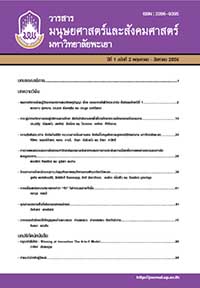การประมาณค่าการปล่อยก๊าซมีเทนจากนาข้าวในจังหวัดพะเยา
Keywords:
มีเทน, นาข้าว, ก๊าซเรือนกระจก, จังหวัดพะเยา, Methane, rice field, greenhouse gas, Phayao provinceAbstract
การศึกษาครั้งนี้มีวัตถุประสงค์เพื่อประมาณค่าการปล่อยก๊าซมีเทนจากนาข้าวในจังหวัดพะเยาปีพ.ศ.2554 ตามวิธีที่กำหนดไว้ในคู่มือการจัดทำบัญชีก๊าซเรือนกระจก ปี พ.ศ. 2539 ของคณะกรรมาธิการระหว่างรัฐบาลด้านสภาพภูมิอากาศเปลี่ยนแปลง (IPCC) โดยการใช้ค่าการปล่อยจาก 3 แหล่งที่มา ได้แก่ 1) ค่าการปล่อยเฉพาะของประเทศ (CSEF) ที่ได้จากการพัฒนาจากการศึกษานี้โดยการประมาณค่าจากงานวิจัยและรายงานการศึกษาการปล่อยก๊าซมีเทนจากนาข้าวในประเทศไทย 2) ค่าการปล่อย (EF) ที่เป็นค่าแนะนำไว้ในคู่มือการคำนวณของIPCC พ.ศ. 2539 และ 3) ค่าแนะนำที่อ้างอิงในรายงานแห่งชาติฉบับที่ 2 (SNC) ปี พ.ศ.2553 ผลการศึกษาพบว่าปริมาณการปล่อยก๊าซมีเทนจากนาข้าวของจังหวัดพะเยา พ.ศ.2554 จากการคำนวณโดยใช้ค่า CSEF มีปริมาณเท่ากับ 30,933 เมกะกรัมต่อปี โดยมีปริมาณการปล่อยก๊าซมากกว่าการคำนวณด้วยค่าการปล่อยของ IPCC และ SNC ประมาณร้อยละ 24 และ 47 ตามลำดับ จากการวิเคราะห์การเปลี่ยนแปลงตามพื้นที่พบว่าอำเภอดอกคำใต้เป็นอำเภอที่มีปริมาณการปล่อยก๊าซสูงที่สุดมีปริมาณการปล่อย 7,257.47 เมกะกรัมต่อปี คิดเป็นร้อยละ 23 ของปริมาณการปล่อยของก๊าซทั้งหมด พื้นที่ปลูกข้าวที่มีปริมาณการปล่อยมากส่วนใหญ่เป็นพื้นที่นาน้ำฝนบริเวณทิศเหนือของจังหวัดพะเยาในเขตพื้นที่อำเภอจุน และอำเภอเชียงคำ ส่วนพื้นที่ที่มีปริมาณการปล่อยน้อยที่สุดส่วนใหญ่จะกระจายอยู่บริเวณที่ราบตอนกลางของพื้นที่อำเภอปง และอำเภอเชียงม่วน ที่มีลักษณะภูมิประเทศของพื้นที่ส่วนใหญ่เป็นพื้นที่ภูเขาและป่าไม้
Estimating methane emissions from rice fields in Phayao province
Siriruk Pimmasarn1, Nakarin Chaikaew2 and Sittichai Pimonsree3*
1 Graduate Student in Environmental Science, School of Energy and Environment, University of Phayao, Phayao 56000
2 Geographic Information Science, School of Information and Communication Technology, University of Phayao, Phayao 56000
3* Environmental Engineering, School of Energy and Environment, University of Phayao, Phayao 56000
The objective of this study is to estimate the methane emissions from rice fields in Phayao Province by using the method defined by the 2006 Intergovernmental Panel on Climate Change (IPCC) Guidelines for National Greenhouse Gas Inventories. The methane emissions were calculated by using the emission factor (EF) from 3 different sources; 1) Country Specific Emission Factor (CSEF), developed from the research papers and study reports of methane emissions in Thailand, 2) the default value from revised 1996 IPCC Guidelines for National Greenhouse Gas Inventories, and 3) the default value from Second National Communication report. The methane estimations using the CSEF indicated that the annual methane emission is 30,933 Mg, which is higher than the calculation using EF from IPCC and SNC (24% and 47%, respectively). The spatial analysis found that Dok Khamtai district was the largest emission, 7,257.47 Mg per year (23% of the total emissions). Most of methane emission emitted from the major rice-rainfed areas in the northern part of Phayao (Chun and Chiang Kham districts). The lowest emission occurred in the middle plain areas of Pong and Chiang Muan districts, which was covered by mountains and forests.Downloads
Published
How to Cite
Issue
Section
License
ผู้นิพนธ์ต้องรับผิดชอบข้อความในบทนิพนธ์ของตน มหาวิทยาลัยพะเยาไม่จำเป็นต้องเห็นด้วยกับบทความที่ตีพิมพ์เสมอไป ผู้สนใจสามารถคัดลอก และนำไปใช้ได้ แต่จะต้องขออนุมัติเจ้าของ และได้รับการอนุมัติเป็นลายลักษณ์อักษรก่อน พร้อมกับมีการอ้างอิงและกล่าวคำขอบคุณให้ถูกต้องด้วย
The authors are themselves responsible for their contents. Signed articles may not always reflect the opinion of University of Phayao. The articles can be reproduced and reprinted, provided that permission is given by the authors and acknowledgement must be given.








